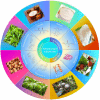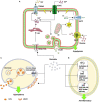Research progress on extraction technology and biomedical function of natural sugar substitutes
- PMID: 36034890
- PMCID: PMC9414081
- DOI: 10.3389/fnut.2022.952147
Research progress on extraction technology and biomedical function of natural sugar substitutes
Abstract
Improved human material living standards have resulted in a continuous increase in the rate of obesity caused by excessive sugar intake. Consequently, the number of diabetic patients has skyrocketed, not only resulting in a global health problem but also causing huge medical pressure on the government. Limiting sugar intake is a serious problem in many countries worldwide. To this end, the market for sugar substitute products, such as artificial sweeteners and natural sugar substitutes (NSS), has begun to rapidly grow. In contrast to controversial artificial sweeteners, NSS, which are linked to health concepts, have received particular attention. This review focuses on the extraction technology and biomedical function of NSS, with a view of generating insights to improve extraction for its large-scale application. Further, we highlight research progress in the use of NSS as food for special medical purpose (FSMP) for patients.
Keywords: diabetes; extraction technology; inflammation; natural sugar substitutes; obesity.
Copyright © 2022 Lei, Chen, Ma, Fang, Qu, Yang, Peng, Zhang, Jin and Sun.
Conflict of interest statement
The authors declare that the research was conducted in the absence of any commercial or financial relationships that could be construed as a potential conflict of interest.
Figures












Similar articles
-
Non-nutritive sweeteners and type 2 diabetes: Should we ring the bell?Diabetes Res Clin Pract. 2019 Sep;155:107786. doi: 10.1016/j.diabres.2019.107786. Epub 2019 Jul 19. Diabetes Res Clin Pract. 2019. PMID: 31326455 Review.
-
Autoimmune Thyroiditis with Hypothyroidism Induced by Sugar Substitutes.Cureus. 2018 Sep 7;10(9):e3268. doi: 10.7759/cureus.3268. Cureus. 2018. PMID: 30430057 Free PMC article.
-
Artificial Sweeteners: Perceptions and Realities.Curr Diabetes Rev. 2023;19(7):e290422204241. doi: 10.2174/1573399818666220429083052. Curr Diabetes Rev. 2023. PMID: 37183396
-
Sugar substitutes: Health controversy over perceived benefits.J Pharmacol Pharmacother. 2011 Oct;2(4):236-43. doi: 10.4103/0976-500X.85936. J Pharmacol Pharmacother. 2011. PMID: 22025850 Free PMC article.
-
Nutritional Interventions and Considerations for the Development of Low Calorie or Sugar Free Foods.Curr Diabetes Rev. 2020;16(4):301-312. doi: 10.2174/1573399815666190807144422. Curr Diabetes Rev. 2020. PMID: 31389314 Review.
Cited by
-
Konjac Glucomannan: An Emerging Specialty Medical Food to Aid in the Treatment of Type 2 Diabetes Mellitus.Foods. 2023 Jan 12;12(2):363. doi: 10.3390/foods12020363. Foods. 2023. PMID: 36673456 Free PMC article. Review.
-
Advances in the Utilization of Zebrafish for Assessing and Understanding the Mechanisms of Nano-/Microparticles Toxicity in Water.Toxics. 2023 Apr 17;11(4):380. doi: 10.3390/toxics11040380. Toxics. 2023. PMID: 37112607 Free PMC article. Review.
-
D-Psicose mitigates NAFLD mice induced by a high-fat diet by reducing lipid accumulation, inflammation, and oxidative stress.Front Nutr. 2025 May 27;12:1574151. doi: 10.3389/fnut.2025.1574151. eCollection 2025. Front Nutr. 2025. PMID: 40497021 Free PMC article.
-
Advances in Antioxidant Applications for Combating 131I Side Effects in Thyroid Cancer Treatment.Toxics. 2023 Jun 13;11(6):529. doi: 10.3390/toxics11060529. Toxics. 2023. PMID: 37368629 Free PMC article. Review.
-
Effects of Oltipraz on the Glycolipid Metabolism and the Nrf2/HO-1 Pathway in Type 2 Diabetic Mice.Drug Des Devel Ther. 2024 Dec 5;18:5685-5700. doi: 10.2147/DDDT.S485729. eCollection 2024. Drug Des Devel Ther. 2024. PMID: 39654602 Free PMC article.
References
-
- World Health Organization . Guideline: Sugars Intake for Adults and Children. Geneva: World Health Organization; (2015). - PubMed
Publication types
LinkOut - more resources
Full Text Sources

